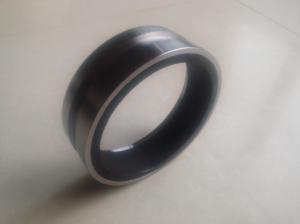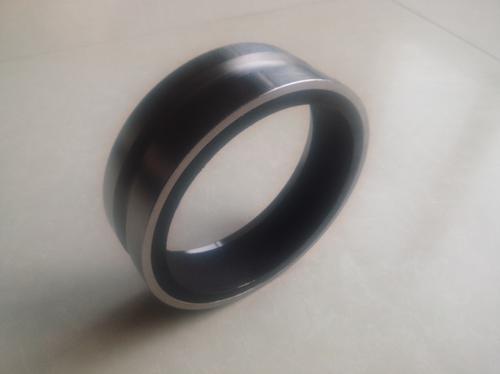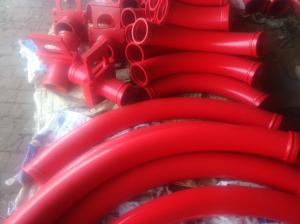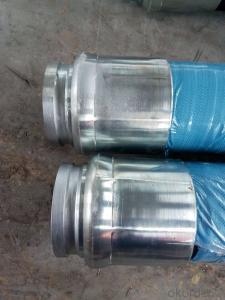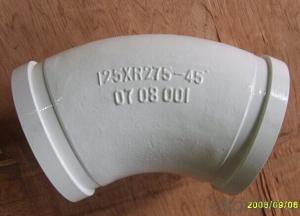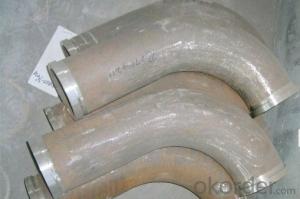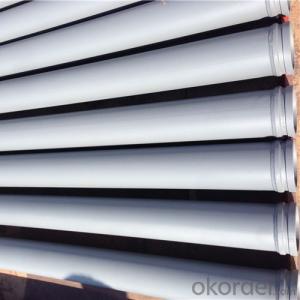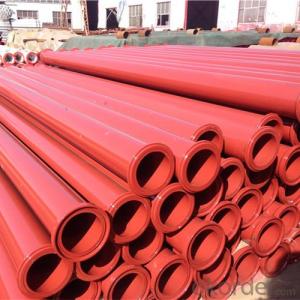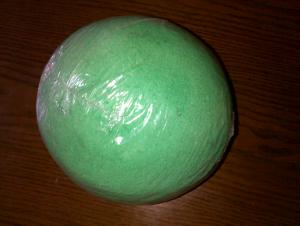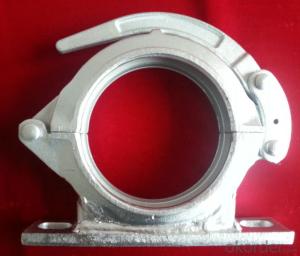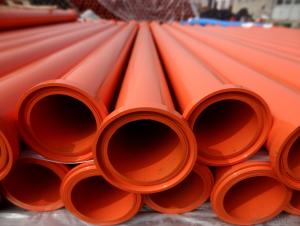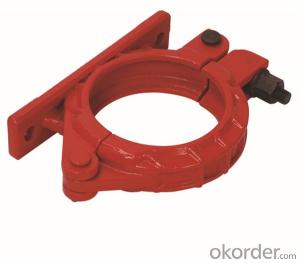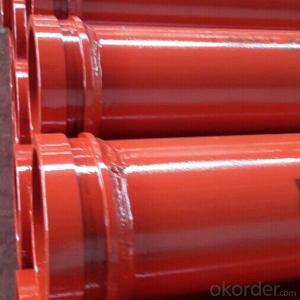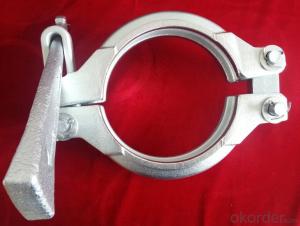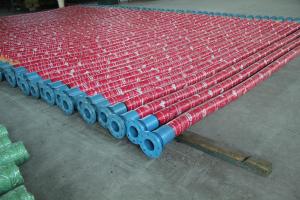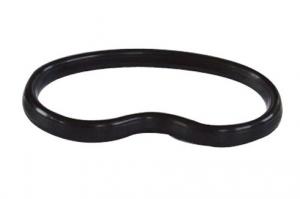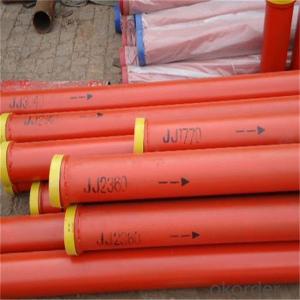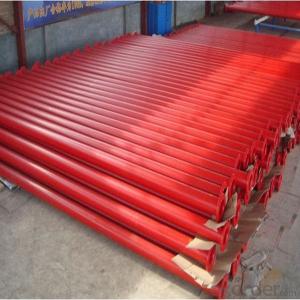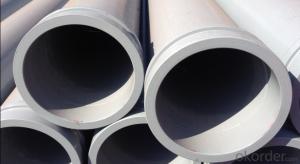Concrete Pump Wearing Flange DN125 with High Quality
- Loading Port:
- Tianjin
- Payment Terms:
- TT or LC
- Min Order Qty:
- 1 pc
- Supply Capability:
- 10000 pc/month
OKorder Service Pledge
OKorder Financial Service
You Might Also Like
Product Description:
Name:Concrete Pump Wearing Flange DN125 with High Quality
Materials: Steel 20
Notes: total series of concrete pump flange for different brand concrete pump
Scope of Application of the Equipment
Wearing Flange DN125 with High Quality is a concrete pump spare parts for combined elbows and delivery pipes in concrete pump operations. It can be widely used in the various types of concrete pump like (PUTZMEISTER, SCHWING, CIFA, SANY, ZOOMLION, IHI, KYOKUTO Etc) available from us.
Product Advantages:
Wearing Flange DN125 with High Quality are durable, strong, and resists corrosion.
Main Product Features:
· Premium quality
· Prompt delivery & seaworthy packing (10-20 days after receiving deposit)
Reliable performance
Easy and smooth operation
High safety.
· Professional Service
· Competitive pricing
Product Specifications:
Every 500pcs Wearing Flange DN125 put in one seaworthy wooden box, and 20 boxes in one 20feet container.
FAQ:
Q1: Why buy Materials & Equipment from us?
A1: All products have its ISO certifications, adheres to the highest standards and a commitment to supply chain safety and customer satisfaction.
Q2: How do we guarantee the quality of our products?
A2: We have established an advanced quality management system which conducts strict quality tests at every step, from raw materials to the final product. At the same time, we provide extensive follow-up service assurances as required.
Q3: How soon can we receive the product after purchase?
A3: Within three days of placing an order, we will begin production. The specific shipping date is dependent upon international and government factors, but is typically 10 to 30 workdays.
Q4: If we can produce some male and female flanges according to customers request?
A4: Yes, we can produce Wearing Flange DN125 according to the difference country situations and different concrete pump to make it suitable to the market and customers. We have very professional technical team to make the design.
Q5: How to make a quick resolution for after service?
A5: We have overseas branches all-around of world, IF needed, the seller shall dispatch 2 engineers to the buyer's site for supervision of training. The buyer shall make available of necessary facilities &skilled personnel at site for training.
Images:
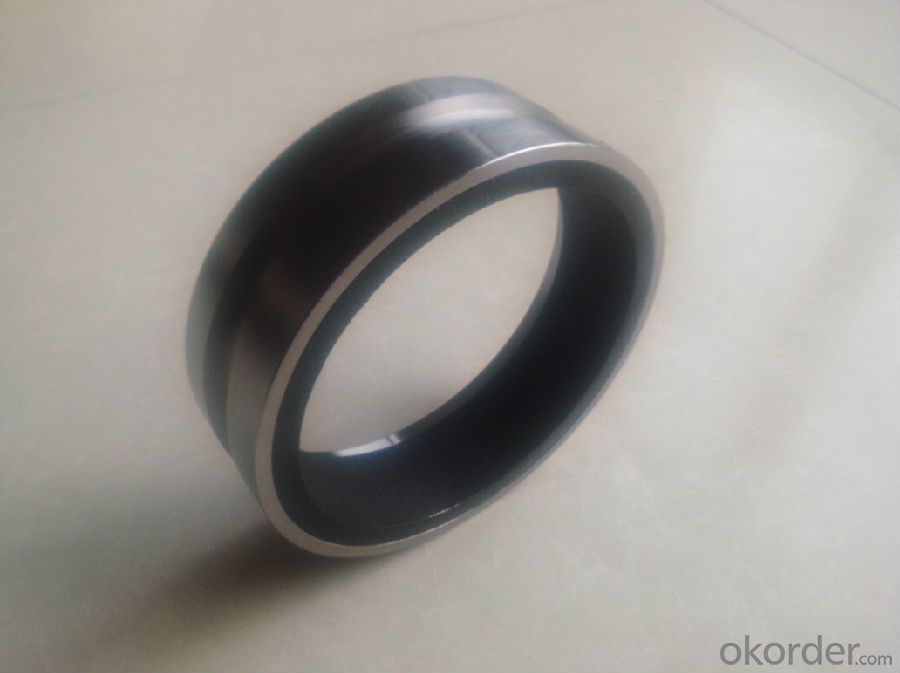
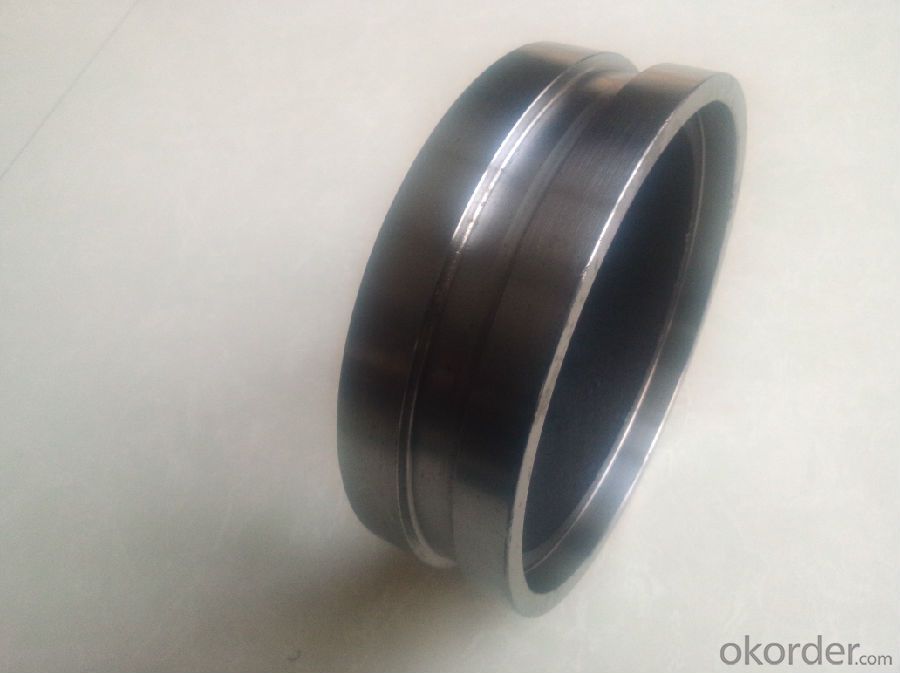
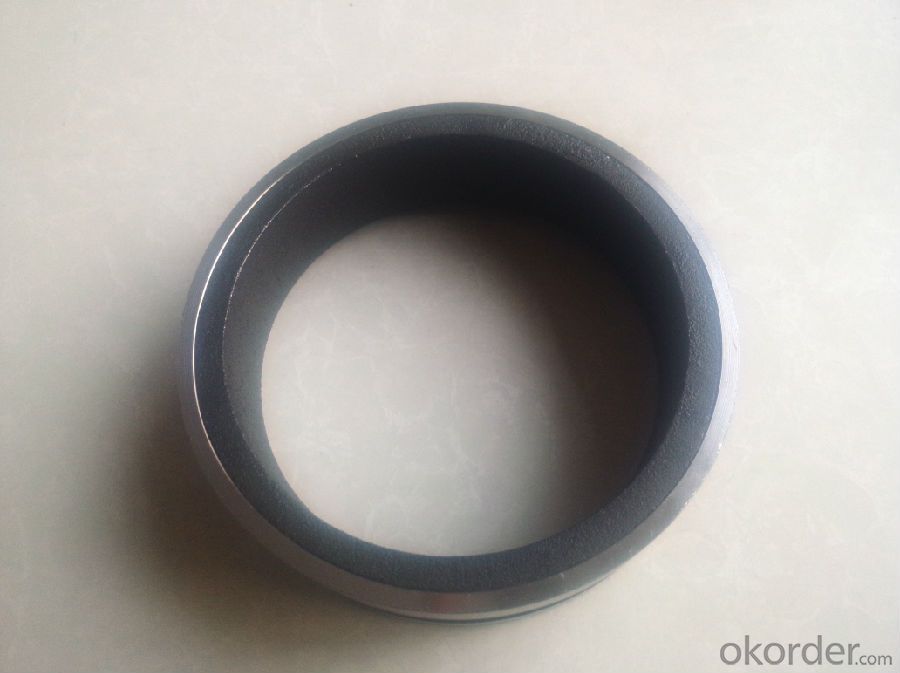
- Q: Can concrete pump spare parts be coated with anti-corrosion or anti-wear coatings?
- Yes, concrete pump spare parts can be coated with anti-corrosion or anti-wear coatings. These coatings provide an additional layer of protection to the spare parts, helping to prevent corrosion and wear caused by the harsh operating conditions and abrasive materials encountered in concrete pumping. The coatings are typically made from materials such as epoxy, polyurethane, or ceramic, which have excellent resistance to corrosion and wear. The application of these coatings can significantly extend the lifespan of concrete pump spare parts, reducing the need for frequent replacements and resulting in cost savings for operators. Additionally, the anti-corrosion and anti-wear coatings can improve the overall performance and efficiency of the concrete pump, ensuring smooth and reliable operation.
- Q: Are there any specific brands or manufacturers that are recommended for concrete pump spare parts?
- Concrete pump spare parts are highly recommended from various reputable brands and manufacturers. Putzmeister, Schwing, Sany, and Zoomlion are among the top brands in the industry that offer high-quality, reliable, and durable products. Their extensive range of spare parts caters to different models of concrete pumps, ensuring customers can easily obtain the specific parts they require. Moreover, these brands have established a strong market presence and possess a wide network of dealers and distributors worldwide, facilitating convenient access to their spare parts. To ensure the longevity and optimal performance of your concrete pump, it is always advisable to select spare parts from renowned brands and manufacturers.
- Q: What are the specifications for concrete delivery pumps?
- The pressure of each safety valve of the hydraulic system of concrete pump shall comply with the requirements of the manual, and the user shall not adjust the change
- Q: What is the purpose of a concrete pump hydraulic oil filter?
- The purpose of a concrete pump hydraulic oil filter is to remove contaminants and impurities from the hydraulic oil, ensuring that the oil remains clean and free from any particles that could potentially damage the pump's components or negatively affect its performance.
- Q: What are the skills of concrete pump?
- The operator and equipment management personnel should carefully read the instructions, grasp the relevant knowledge of the structural principle, use and maintenance as well as pumping concrete; use and operation of the concrete pump, should be strictly in accordance with the execution of instructions
- Q: What are the indications of a faulty concrete pump hydraulic motor?
- There are several signs that can indicate a malfunctioning hydraulic motor in a concrete pump. Some common indicators to watch for are: 1. Power loss: If the hydraulic motor is not working correctly, you may notice a significant decrease in power in the concrete pump. The motor may struggle to generate enough force to effectively pump the concrete, resulting in slower or weaker output. 2. Unusual noises or vibrations: A faulty hydraulic motor may produce abnormal sounds or vibrations while in operation. This could be due to damaged internal components or misalignment, indicating an issue with the motor. 3. Leaking fluids: Proper flow and pressure of hydraulic fluid are essential for the functioning of hydraulic motors. If you observe any fluid leaks around the hydraulic motor or its associated parts, it could be a sign of a faulty motor that requires attention. 4. Overheating: A malfunctioning hydraulic motor may overheat due to increased friction or internal problems. If you notice excessive heat emanating from the motor or its associated parts, it is crucial to address the problem promptly to prevent further damage. 5. Inconsistent or jerky movement: A faulty hydraulic motor can cause the concrete pump to operate unevenly or jerkily. This can result in uneven pouring or difficulty in controlling the flow of concrete, indicating an issue with the motor's performance. 6. Increased energy consumption: A faulty hydraulic motor may consume more energy to function properly. This can lead to a noticeable rise in energy usage, which can be observed through higher electricity bills or added strain on other components of the pump's system. It is important to remember that these signs may vary depending on the specific make and model of the concrete pump hydraulic motor. It is always recommended to consult the manufacturer's guidelines or seek professional assistance to effectively diagnose and address any issues with the hydraulic motor.
- Q: Can I get spare parts for concrete pump boom arms and pipes?
- Yes, spare parts for concrete pump boom arms and pipes are available. Many manufacturers and suppliers offer a wide range of spare parts specifically designed for concrete pump boom arms and pipes. These spare parts can be easily found and purchased from authorized dealers or online stores. It is important to ensure that you provide accurate specifications and details of your concrete pump model to find the correct spare parts for replacement or repair.
- Q: What is the purpose of a concrete pump piston?
- The purpose of a concrete pump piston is to provide the necessary pressure to push the concrete mixture from the hopper into the delivery pipeline. The piston is responsible for generating the force required to propel the concrete through the system, effectively transporting it to its intended destination. This is achieved by the reciprocating motion of the piston, which creates suction on one side and pressure on the other, enabling the concrete to be pushed forward. Overall, the concrete pump piston plays a crucial role in facilitating the efficient and continuous movement of concrete, making it an essential component in construction projects that require the precise and timely placement of concrete.
- Q: How can one determine the correct weight and balance requirements for concrete pump spare parts?
- To determine the correct weight and balance requirements for concrete pump spare parts, several factors need to be considered. Firstly, it is important to consult the manufacturer's specifications and guidelines for the specific concrete pump model. These documents often provide detailed information about the weight and balance requirements for each spare part. Secondly, understanding the function and purpose of each spare part is crucial. Different parts have varying weights and may have an impact on the overall balance of the pump. For instance, larger components such as booms or outriggers may require specific weight distribution to ensure stability during operation. Furthermore, considering the intended use and conditions of the concrete pump is essential. If the pump is expected to work in challenging terrains or extreme weather conditions, additional weight may be required to enhance stability. In addition to the manufacturer's guidelines, consulting with experts or engineers familiar with concrete pumps can provide valuable insights. They can help analyze the specific requirements of the pump and advise on the correct weight and balance requirements for the spare parts. Lastly, it is crucial to conduct thorough testing and inspections after installing any spare parts. This ensures that the weight and balance requirements are met, and any adjustments can be made if necessary. Overall, determining the correct weight and balance requirements for concrete pump spare parts involves a combination of understanding manufacturer guidelines, considering the purpose and conditions of the pump, seeking expert advice, and conducting proper testing and inspections.
- Q: What are the indications of an inaccurate concrete pump pressure gauge?
- There are several indications that can suggest an inaccurate concrete pump pressure gauge. Here are a few: 1. Inconsistent readings: If the pressure gauge consistently gives varying readings even when the concrete pumping conditions remain constant, it could be a sign of an inaccurate gauge. For example, if the gauge displays a pressure of 1000 psi one moment and then jumps to 1500 psi without any significant changes in the pumping operation, it could indicate an issue with the gauge. 2. Unusual or abnormal readings: If the pressure gauge consistently displays extremely high or low pressure readings that are significantly different from the expected values, it could signify an inaccurate gauge. It is important to be aware of the typical pressure range for the specific concrete pumping operation to identify abnormal readings. 3. Incongruity with other gauges: If there are multiple pressure gauges installed in the concrete pumping system, and they provide significantly different readings, it could suggest that one or more of the gauges are inaccurate. Comparing the readings of various gauges can help determine if a particular gauge is faulty. 4. Inadequate pump performance: If the concrete pump is not performing as expected, such as experiencing reduced output or inconsistent flow rates, it could be due to inaccurate pressure readings. Inaccurate pressure measurements can affect the control of the pump's hydraulic system, leading to inefficiencies in pumping operations. 5. Physical damage or wear: Any visible damage or signs of wear on the pressure gauge, such as cracked glass, bent needles, or loose connections, can compromise its accuracy. Such physical damage can lead to inaccurate readings and should be addressed promptly. It is important to regularly calibrate and maintain the pressure gauge to ensure accurate readings. If any indications of an inaccurate gauge are observed, it is recommended to consult a professional technician or engineer to assess the situation and take appropriate actions to rectify the issue.
Send your message to us
Concrete Pump Wearing Flange DN125 with High Quality
- Loading Port:
- Tianjin
- Payment Terms:
- TT or LC
- Min Order Qty:
- 1 pc
- Supply Capability:
- 10000 pc/month
OKorder Service Pledge
OKorder Financial Service
Similar products
Hot products
Hot Searches
Related keywords
